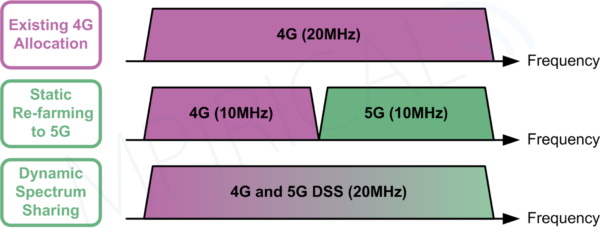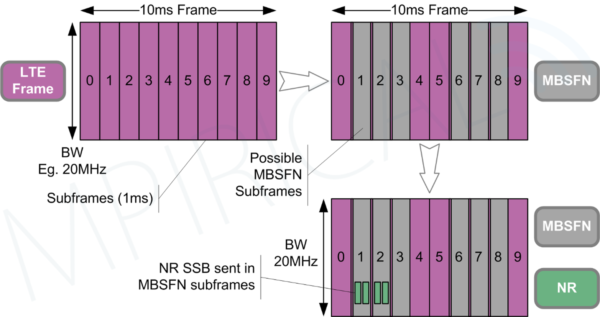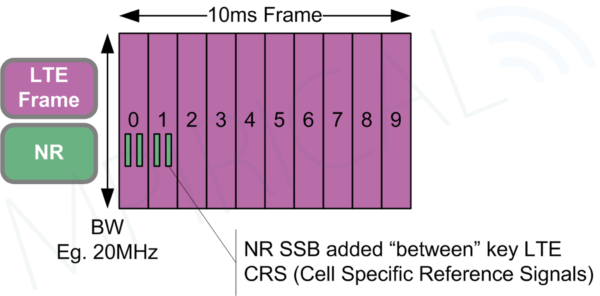
Enhancing 5G deployments with DSS (Dynamic Spectrum Sharing)
A key part of deploying 5G NR (New Radio) is identifying the radio spectrum to utilize. DSS (Dynamic Spectrum Sharing) has been a hot topic over the early deployments of 5G, enabling some service providers to utilize existing 4G LTE spectrum.
The current focus for many service providers is the continued roll-out of 5G, with some focusing on 5G NSA (Non-Standalone) and others that have launched 5G SA (Standalone). However, they all share the same challenge related to the choice of radio spectrum bands that should be assigned to provide 5G coverage and capacity. For some, this challenge is eased by the local regulator freeing up new spectrum. Unfortunately, the challenge for most is how to re-use existing LTE spectrum when there is still a high penetration of LTE devices that do not support 5G SA or NSA operation. One solution is DSS (Dynamic Spectrum Sharing).
Dynamic Spectrum Sharing
Dynamic Spectrum Sharing enables service providers to perform a “soft re-farming” of LTE spectrum towards 5G NR. In so doing, it allows the service providers to leverage existing 4G spectrum to enhance their 5G offering. Compared to static re-farming, which could see the 4G service for a specific frequency band drastically reduced, Dynamic Spectrum Sharing enables “dynamic” resource allocation between 4G and 5G in a band.

The Key Challenge of DSS
The key part of any coordination/coexistence between LTE and NR must solve the fact that the two systems have very different “pilot” and “synchronization signals” which are required by devices when synchronizing and accessing the network. In comparison, the LTE pilot signals occupy specific locations in the time and frequency domain. By design, 5G is far more flexible, with pilot signals transmitted as part of a SSB (Synchronization Signal Block). To solve this collision problem, there are two techniques utilized: a MBSFN (Multicast-Broadcast Single Frequency Network) option and a Non-MBSFN option.
MBSFN (Multicast-Broadcast Single Frequency Network) Option for DSS
MBSFN is a feature which has been in LTE for many years and was standardized as a method to allow the LTE spectrum to be used for a Broadcast/Multicast network. When it comes to DSS, this technique can be used as a method to inform LTE devices that certain points in time (subframes) are not used for “normal” LTE operation. These subframes can then be utilized by the 5G system to broadcast the necessary SSB (Synchronization Signal Block) for 5G devices. This is illustrated in Figure 2. Not illustrated is the actual allocation of LTE and 5G resources. It’s worth noting that 5G devices can utilize both the LTE subframes and MBSFN subframes. Unfortunately, older LTE devices won’t be able to utilize the MBSFN subframes (since they have been informed not to), however the latest LTE devices supporting specific beamforming options will.

Non-MBSFN Option for DSS
The second option relies on the fact that in some specific 5G deployment scenarios it is possible to “rate adapt” or “squeeze” the NR SSB information between the vital LTE CRS (Cell Specific Reference Signals).

DSS Limitations
Unfortunately, there are a few downsides/limitations when using DSS. First, DSS operation adds overhead and as such there is a reduction in the performance of both the 4G LTE and 5G NR systems. This is typically estimated at ~25% reduction in 4G and ~15% in 5G. In addition, it is worth noting that there are many complexities depending on the frequency band chosen, whether it’s FDD (Frequency Division Duplex) or TDD (Time Division Duplex), as well as the specific capabilities of the devices. As such, in some specific DSS scenarios Release 16/17 devices are required (which delays when DSS can be used in some bands).
Conclusion
DSS may have a role to play in some 5G deployments, but not all. Whilst the penetration of 5G devices is still low, DSS enables some service providers with limited spectrum not to have to re-farm their 4G band to 5G. However, depending on the future spectrum options in that country, it may be a short term solution. It makes little sense for service providers which have access to dedicated 5G low band frequencies or newly allocated 5G spectrum to consider DSS.
DSS is best suited for coverage, i.e. being deployed on a 4G coverage layer to ensure 5G coverage and the 5G logo is seen. The concern here is the end user’s “5G experience”; when seeing a 5G logo on their device, they will not expect to get a service experience that is comparable to 4G.
If you would like to learn more about 5G, our expert instructors provide live classroom and on-demand Introduction to New Radio course.
